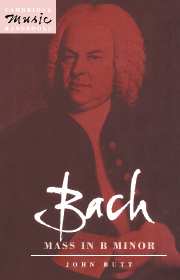Book contents
- Frontmatter
- Contents
- Preface
- List of abbreviations
- 1 The musical genre of the mass Ordinary
- 2 Genesis and purpose
- 3 Reception history
- 4 Text and music: the process of adaptation and composition
- 5 Ritornello forms
- 6 The influence of the dance
- 7 Counterpoint
- 8 Figurae and the motivic texture
- 9 Patterns and proportions: large-scale structuring and continuity in the Mass in B Minor
- Afterword
- Notes
- Select bibliography
- Index
1 - The musical genre of the mass Ordinary
Published online by Cambridge University Press: 05 June 2012
- Frontmatter
- Contents
- Preface
- List of abbreviations
- 1 The musical genre of the mass Ordinary
- 2 Genesis and purpose
- 3 Reception history
- 4 Text and music: the process of adaptation and composition
- 5 Ritornello forms
- 6 The influence of the dance
- 7 Counterpoint
- 8 Figurae and the motivic texture
- 9 Patterns and proportions: large-scale structuring and continuity in the Mass in B Minor
- Afterword
- Notes
- Select bibliography
- Index
Summary
The Mass in B Minor dominates Bach's oeuvre as a work reaching well beyond the bounds of its practical and stylistic context. Bach was doubtless aware that he was compiling a work within the longest tradition of compositional genres, one which would probably continue for several centuries after his death. The mass text itself dates back to the earliest years of the Christian era and is an important symbol of the western cultural tradition. The earliest notated sources of music include settings of mass texts and the tradition for assembling musical cycles of the Ordinary (those sung parts of the mass which are not varied according to the liturgical calendar) stems from the fourteenth century.
Only with the stylistic developments around 1600 did the mass cease to be the most important single musical genre. The growth of operatic styles and the increasing autonomy of instrumental music are symptomatic of broader changes in cultural perspective. Nevertheless the musical genre of the mass was not laid aside: composers who were primarily concerned with the early operatic genres of the seconda prattica (such as Monteverdi and Cavalli) continued to compose masses. These were generally in the ‘old style’, the prima prattica as codified by theorists such as Zarlino and most commonly associated with the compositional style of Palestrina and his contemporaries.
The early eighteenth-century mass is no longer the single specific genre of the high Renaissance; rather it is a conglomeration of musical structures drawn largely from the immediate environments of court and theatre.
- Type
- Chapter
- Information
- Bach: Mass in B Minor , pp. 1 - 6Publisher: Cambridge University PressPrint publication year: 1991

